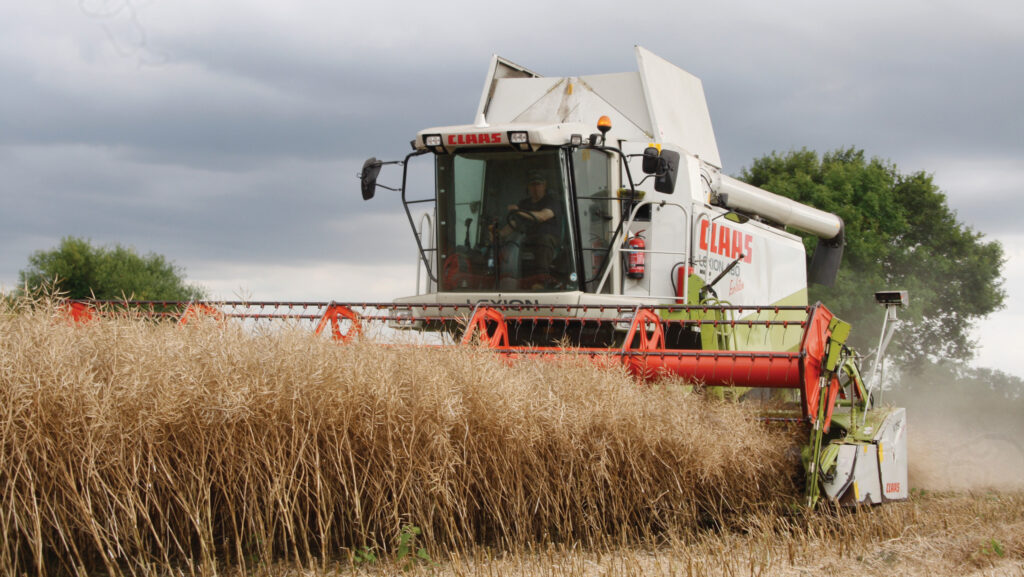Harvest 24: Good rapeseed quality, but tonnage down
 © Ian Fletcher
© Ian Fletcher Crop quality and yields are varying widely across the regions, although dry weather is enabling growers to get on with combining without worrying about high drying costs.
Farmers have harvested a fair amount of oilseed rape now, but Ed Hodgson, head of trading at Openfield, believes the overall harvest picture is yet to be fully understood, with busy weeks still ahead.
Running just under three weeks behind schedule, oilseed rape yields are “surprisingly good”, achieving an average of 2.5-3.7t/ha. And while winter barley harvest is under way, there is still a lot to come in, and he predicts yields will be down this year.
See also: Harvest 24: Contractor seeks OSR replacer after poor crop
A key area of focus will be nitrogen levels in barley and protein contents in wheat, with the former running lower than last year following the wet spring.
“It’s still too early to judge, but there are a huge amount of question marks over quality,” he says.
“Our growers are reasonably stoic looking ahead, but it will be more of a hand-to-mouth approach from a selling point of view, with more spot buying.”
Lincolnshire
It’s a similarly mixed picture at Woldgrain near Gainsborough, which has so far received 600t of oilseed rape and 3,500t of winter feed barley.
So far, the oilseed rape has been of good quality, with oil contents averaging 45%, but operations manager Dan Murphy says this year will see the lowest tonnage to date.
“It will be the lowest tonnage of oilseed rape I have known and, for the first time ever, all our crop will fit into one bin,” he says. “It’s just not financially viable, even though growers need it in their rotations.”
Some 10 years ago, Woldgrain was taking in 18,000t of rapeseed – this year will be more like 3,000t, which he believes is a combination of fluctuating weather conditions and increased legislation around plant protection products.
Feed barley, consisting of mainly Tardis with some Kingsbarn, is averaging 67kg/hl with moisture contents ranging from 13% to 19%, says Dan.
“It is on the drier side for us, and operationally it helps because you can get the crop through the store quicker.”
Reflecting on this year’s spring barley harvest, Dan expects significant intakes to start this week (1 August).
“We are expecting about 20,000t of Planet and Laureate – but with many growers still drilling in May, harvest could be as late as September, which is very new for us.”
Cambridgeshire
Moving further south, Camgrain has almost finished oilseed rape intakes, with lower yields as anticipated. Averaging 4t/ha, the variance between growers is vast, with some as low as 1t/ha. But oil contents are looking strong.
Winter malting barley is looking particularly low in nitrogen, averaging 1.4-1.5%, but there are no problems with moisture or specific weights, at 14% and 60-62kg/hl, respectively.
Group chief executive officer Simon Willis is expecting winter wheat to start coming in from 5 August, and is hopeful that the weather plays ball.
“Most of the wheat in East Anglia will become fit and ready to harvest in the next few days so there is a lot to play for. It’s a crucial time.”
Isle of Wight
The mixed results are mirrored in East Cowes, where Mark Olick is experiencing the aftermath of last winter’s torrential rain at Newbarton Farm.
He lost almost a third of his oilseed rape crop, dropping from 44ha to 20ha. And yields have been disappointing too, averaging 1.2t/ha compared with the usual 3.7t/ha, although the oil content remains strong.
The winter wheat is ready to be cut, with Zyatt testing at 14% moisture.
Mark is hopeful that the decent weather will remain and allow him to cut the 75ha without problem – a far cry from last year when rain destroyed his milling wheat and he was forced to combine in the rain.

